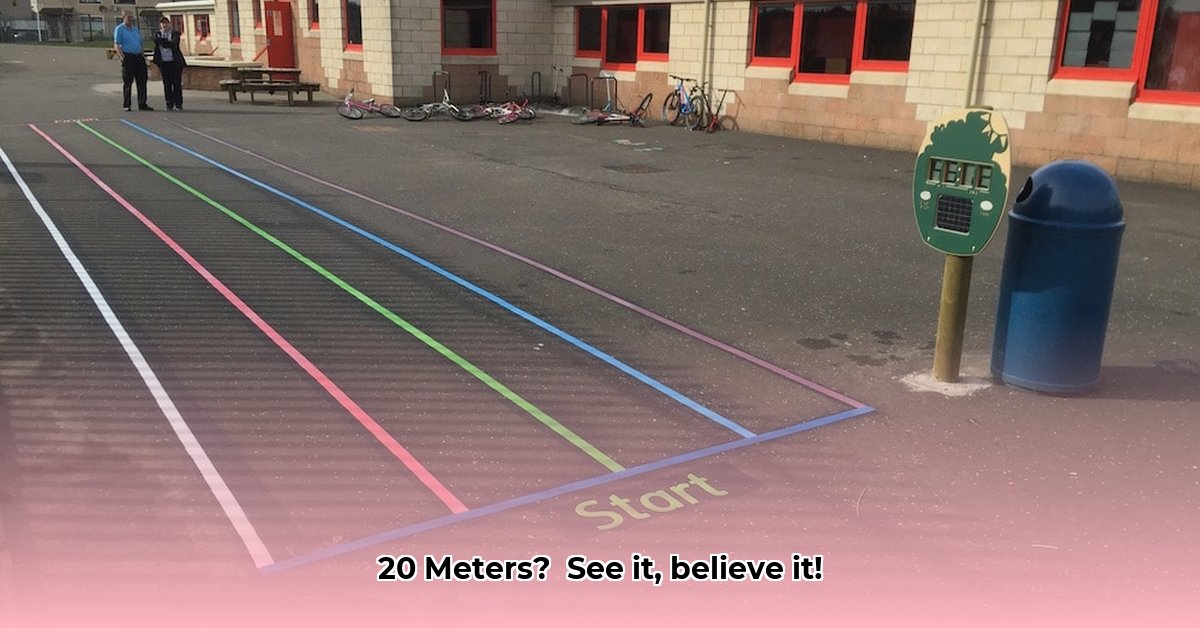Understanding the length of 20 meters can be tricky without a tangible reference point. This guide provides diverse examples, comparisons, and practical applications to help you visualize this measurement accurately. For more conversions, see our guide on meter to feet conversions.
Visualizing 20 Meters with Everyday Objects
Imagine two standard school buses parked end-to-end. That’s roughly 20 meters. Alternatively, picture a line of approximately six average-sized cars—another helpful visualization. A typical city block offers yet another relatable estimate, though actual block lengths can vary significantly. In a park setting, 20 meters could be the pleasant stroll across a small green area. A standard shipping container (20 feet long) is slightly shorter than 20 meters.
20 Meters in Different Settings: Sports, Roads, and Buildings
Think of a standard Olympic-size swimming pool; its length is exactly 50 meters, so 20 meters represents a significant portion, almost half the length. On a two-lane road, 20 meters approximates the width, although road designs can vary. In a stadium, visualize a substantial portion of the track’s straight section – that could be close to 20 meters. A six-story building is typically around 20 meters tall.
Converting 20 Meters to Imperial Units
For those accustomed to the imperial system:
- Yards: 20 meters equals approximately 21.87 yards, close to the length of a first down in American football.
- Feet: 20 meters is about 65.6 feet, a bit longer than the average bowling lane.
- Inches: 20 meters converts to roughly 787.4 inches, about the height of a stack of ten standard doors.
These conversions provide a more tangible grasp for those less familiar with the metric system.
Practical Applications: Construction, Landscaping, and More
Accurate measurements are critical in various fields. In construction, 20 meters is a common dimension for foundations of smaller buildings or the length of a prefabricated wall section. When landscaping, imagine a 20-meter long garden bed or the perimeter of a small yard. Precise measurements are also crucial in sports, such as marking distances for track and field events or determining the dimensions of a playing area. Understanding 20 meters and its imperial equivalents ensures accuracy and prevents costly mistakes.
Beyond Length: Area and Volume using 20 Meters
While 20 meters defines a length, it can also be a component of area and volume calculations. Imagine a square plot of land with 20-meter sides; its area would be 400 square meters (20m x 20m). Now, visualize a cube with 20-meter edges; its volume is a substantial 8,000 cubic meters (20m x 20m x 20m). Understanding these concepts helps visualize the scale and magnitude of projects involving 20-meter dimensions.
Quick Reference Table for 20 Meters
| Comparison | Approximate Equivalent |
|---|---|
| School Buses | 2 School Buses (end-to-end) |
| Cars | 6 Average-Sized Cars |
| City Block | Approximately 1 City Block |
| Shipping Container | Slightly longer than a 20-foot container |
| Olympic Pool | Almost half the length |
| Two-Lane Road | Approximate width |
| Six-Story Building | Approximate height |
| Yards | 21.87 yards (almost a first down in football) |
| Feet | 65.6 feet (longer than a bowling lane) |
| Inches | 787.4 inches (about 10 stacked doors) |
This multifaceted approach, combining real-world examples with practical applications and conversions, provides a thorough understanding of the length of 20 meters.
- Unlock Ancient Roman Jewelry’s Secrets: History, Materials, & Symbolism Revealed - August 14, 2025
- Unveiling Ancient Roman Mythical Creatures: Legends, Powers & Origins Defined for Today’s Enthusiast - August 14, 2025
- Unlock Ancient Secrets: Ancient Roman Attire Women, Status, & Materials [Guide] - August 14, 2025
















